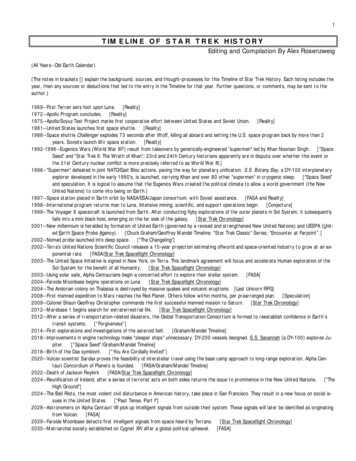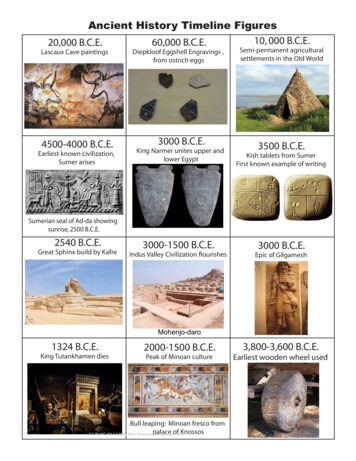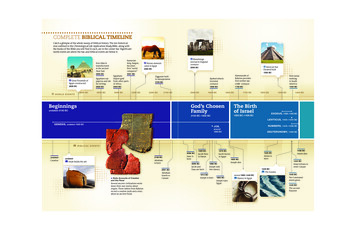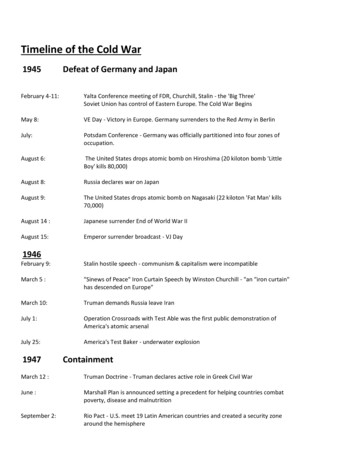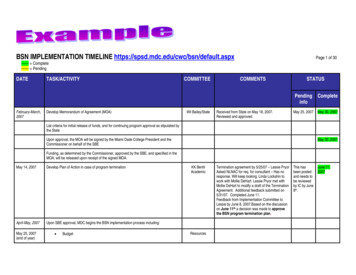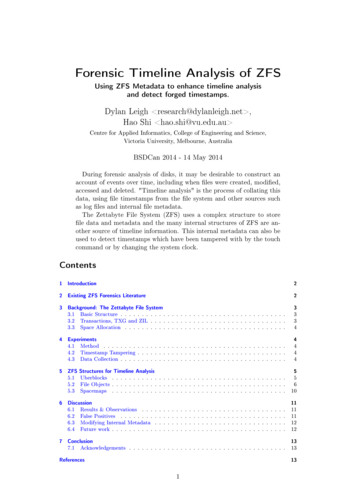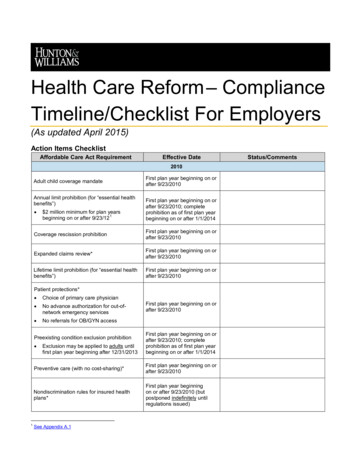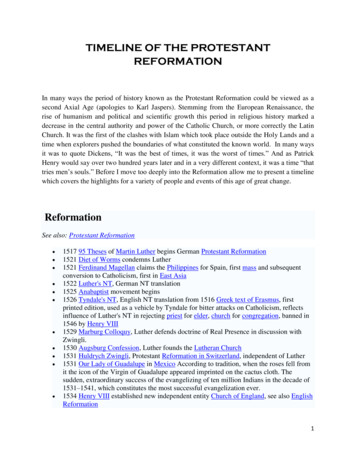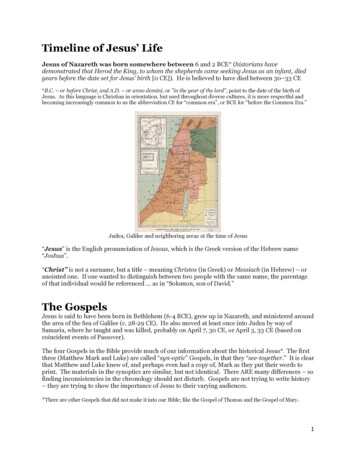
Transcription
Timeline of Jesus’ LifeJesus of Nazareth was born somewhere between 6 and 2 BCE* (historians havedemonstrated that Herod the King, to whom the shepherds came seeking Jesus as an infant, diedyears before the date set for Jesus’ birth [0 CE]). He is believed to have died between 30–33 CE*B.C. – or before Christ, and A.D. – or anno domini, or "in the year of the lord", point to the date of the birth ofJesus. As this language is Christian in orientation, but used throughout diverse cultures, it is more respectful andbecoming increasingly common to us the abbreviation CE for “common era”, or BCE for “before the Common Era.”Judea, Galilee and neighboring areas at the time of Jesus“Jesus” is the English pronunciation of Iesous, which is the Greek version of the Hebrew name“Joshua”.“Christ” is not a surname, but a title – meaning Christos (in Greek) or Messiach (in Hebrew) – oranointed one. If one wanted to distinguish between two people with the same name, the parentageof that individual would be referenced as in “Solomon, son of David.”The GospelsJesus is said to have been born in Bethlehem (6-4 BCE), grew up in Nazareth, and ministered aroundthe area of the Sea of Galilee (c. 28-29 CE). He also moved at least once into Judea by way ofSamaria, where he taught and was killed, probably on April 7, 30 CE, or April 3, 33 CE (based oncoincident events of Passover).The four Gospels in the Bible provide much of our information about the historical Jesus*. The firstthree (Matthew Mark and Luke) are called “syn-optic” Gospels, in that they “see-together.” It is clearthat Matthew and Luke knew of, and perhaps even had a copy of, Mark as they put their words toprint. The materials in the synoptics are similar, but not identical. There ARE many differences – sofinding inconsistencies in the chronology should not disturb. Gospels are not trying to write history– they are trying to show the importance of Jesus to their varying audiences.*There are other Gospels that did not make it into our Bible; like the Gospel of Thomas and the Gospel of Mary.1
Mark (written before 75 AD) by an Aramaic speaking follower in rudimentary Greek. His style ishurried a frequently used term is “immediately.” Mark emphasizes Jesus’ divine power strongly.Matthew (75–85 AD) was probably written by a Jewish scribe, conversant with Judaism, who hasconverted to Christianity. He writes soon after the destruction of the 2nd Temple (70 CE). His writingsuggests the time of friction when Christians and Jews were still “one” but in a “family argument” struggling with each other’s roles. Matthew takes pains to show his fellow Jews that Jesus is “a newMoses,” a fulfiller of the Covenant.Luke (95-110 AD) uses the most elegant Greek, and was probably a Gentile. Tradition says he was“Luke the physician” who travelled with St. Paul. He is not as familiar with Jewish practices,policies, or places as Mark or Matthew. He is concerned to explain Christianity to a wider Gentileaudience. He often repeats themes twice, say in a parable, once with a female and once with a male,protagonist.John (90–125 AD) is NOT one of the synoptics. He writes in a very different style. He has had thelongest time to reflect on the meaning of Jesus’ life, and so shows a more distilled, and symbolicapproach. He emphasizes several signs that Jesus shows. It is he who emphasizes Jesus as lamb ofGod, whose blood, like that of the Passover lamb, saves the follower of God.Jesus’ Birth and Childhood"Adoration of the Shepherds" by Gerard van Honthorst, 1622The Gospel of Mark begins with John the Baptist, and Jesus as an adult already. Matthew includes agenealogy that shows Jesus’ ancestry beginning with Abraham (Jewish focus). Luke pushes thatorigin earlier with a genealogy beginning with Adam (universal focus). John, with the famousprologue (in the beginning the Word was with God) locates Jesus’ beginning before creation (he isthe Cosmic, pre-existent, Christ).The nativity narratives are found only in Matthew (focus on Joseph) and Luke (focus on Mary). St.Paul who was executed in Rome before any of the Gospels were written, seems to know nothing ofJesus’ birth, or ignores it as not crucial to understanding Jesus.2
12-year-old Jesus in the temple by James TissotVery little known of Jesus early life. Matthew held Jesus to have been born in Bethlehem; fled toEgypt; and returned to Nazareth, in the pattern of Moses, leading the people tosalvation/freedom/promised land. Luke describes Jesus as a teen-aged prodigy who discussestheology with the elders in the Temple while his family think he is heading home with them in thelarge caravan of travellers.Depending on the Gospel read, Jesus made one or many pilgrimages to Jerusalem for Passover.Jesus was called a (tekton), or son of a tekton. Although traditionally translated as"carpenter", tekton (as in "technical" and "technology") could better translate as “builder”. It ispossible he and his father both worked as stone masons in the larger economically important Greektown of Sepphoris just west of Nazareth. The Gospel of Thomas has more stories of his youth.Trevisani's depiction of the baptism sceneJesus was baptized by his cousin John as an adult at about 29 years of age in the River Jordan – theactual site is disputed, but probably was near the north end of the Dead Sea at a place today calledQasr al Yahud (or Castle of the Jews). The Gospels from Mark to John gradually diminish John’spresence at the baptism.3
Ministry around CapernaumJesus spends 40 days in the desert reflecting on ministry and temptations. He then travels back toGalilee in the north and begins his ministry.The first thing Jesus does is call companions or community to travel with him. They move aroundthe relatively small area of Galilee, where he preaches, teaches, heals, lives life, and performsmiracles. The main message he gives is for people to “repent” – metanoeo – which means “turnaround” “for the Kingdom of God is at hand.”“Kingdom,” the most usual translation of Basileia might better be translated “rule” or “King-ship”.Jesus is saying the age where God is in charge (sovereign) has begun. Jesus is not a King like Herodor Caesar; his rule is one of love and justice and relationship, hence “Kin ship” is a helpfultranslation of his emphasis.He taught (on the basis of Jewish scriptures) the greatest commandment was the Shema: "Youshall love the Lord your God with all your heart, and with all your soul, and with all your mind . Anda second is like it: ‘You shall love your neighbor as yourself." Both of these commands arise fromTanakh. The Shema references the first Commandment in Ex. 20.19th-century painting Sermon on the Mount, by Carl BlochThe Sermon on the Mount (in Matthew; on the Plain in Luke) shows Jesus both affirming theLaw given on Sinai, and amplifying it with his own rabbinic explanations. Some scholars suggest hewas making the Law impossible to fulfill so that one would necessarily recognize a need for divinegrace.Jesus taught in parables – a form found in many of Jesus' teachings. These are not fables ormorals in the usual sense –heavenly stories with an earthly purpose. They are more like evocativepuzzles designed to engage the listeners, to question for themselves what is going on like a TrojanHorse, the spirit of the parable sneaks inside the hearer, who then takes responsibility to wrestle anddiscover truth for themselves.Miracles accompanied Jesus teaching, but were not his primary purpose. As God is sovereign,God’s will IS BEING done on earth as in heaven. Consequently relationships are set right including each person’s relationship to life healings are a sign of what God wants for us – life inabundance. Nature once again falls under God’s order – so even wind and waves obey God’s child –Jesus.4
Jesus cleansing a leper –mosaic from Monréale CathedralThe Galilean Ministry period ends with Peter recognizing that Jesus is the Messiah, at CaesareaPhilippi (modern day Banios) at the headwaters of the Jordan. The location was a “shopping mall ofspirituality” with temples to Zeus and Pan and others carved into the cliff walls at the foot of Mt.Hermon. At that point, Jesus turns his face toward Jerusalem, and the inexorable movement towardconfrontation with the powers of this world.Carracci's 1594 transfiguration of JesusThe Transfiguration follows where Jesus is seen with the greatest law giver (Moses) and prophet(Elijah) of Tanakh. The gradual disclosure of the identity of Jesus to his disciples and his predictionof his own suffering and death follow. The Transfiguration reaffirms Jesus is the Son of God (as inhis baptism), and the command "listen to him" identifies him as God's messenger and mouthpiece.Jesus then moves toward Jerusalem along the Jordan River route (although the locations jumparound somewhat), teaching along the way.5
Ministry around JerusalemJesus' final entry into Jerusalem, by Jean-Léon Gérôme, 1897Jesus enters Jerusalem from the East (Bethany and Bethphage). Here he is confronting authority inan act of prophetic drama – riding a donkey into the capital during the high holy days of Passover (aFreedom Festival). The city may have had as many as 100,000 pilgrims present so it was anexplosive environment. He was directly challenging the authorities but doing so in a distinctlynon-violent way, so as not to trigger violence. The donkey, the cries of Hoshiyana (God save us!),and the palm leaves referenced the arrival of OT warriors liberating Jews from Greek domination.Jesus possibly taught and healed in Jerusalem for as many as six weeks before he is arrested. Theporticoes of Solomon, the collonaded passageways surrounding the temple mount were narrow, andcrowded, and so not accessible to the movement of many soldiers who were sent to arrest him. Jesusevades capture in the crowds and flits out of the city to overnight with his friends Mary, Martha andLazarus in a nearby town.The Last Supper, 16th C. Juan de JuanesThe night before his arrest Jesus arranges a Last Supper (the Passover meal in the Synoptics,Passover Eve in John) with his twelve key followers (later called the apostles, or the “sent”). Thismeal appears in all four Biblical gospels and the traditional words instituting the sacrament of theLord’s Supper appears in the first letter of Paul to the Corinthians (1 Cor. 11). John does not refer tothe meal directly, as Jesus is sacrificed as the Passover lamb a day earlier in his telling. Instead Johnrefers to the washing of his disciples' feet.One of the 12, Judas Iscariot (which means Judas of the City, perhaps more sophisticated than theGalillean fishermen), leaves the supper and goes to the Jewish authorities and offers to lead them toJesus in the olive gardens below the eastern walls of the Temple (Gethsemane). The 30 silver coinshe was paid have become symbolic of “selling out”. Judas may have thought he was forcing Jesus toreveal himself in power, and foment an uprising of Jesus’ followers. Judas identifies Jesus with akiss, and he is arrested without risk of antagonizing crowds. Peter betrays Jesus by denying himthree times as Jesus said he would. The rest of the disciples flee – suggesting that all have betrayedhim.6
17th C. kiss of Judas and arrest of Jesus by CaravaggioJesus is brought to Caiaphas’ house where he is beaten and tried in an illegal court (at night). He isthen marched to the Roman Governor Pontius Pilate in hopes of finding a sentence of death. Thehistorical Pilate was a brutal leader who was subsequently fired by Caesar for being too violent. Inlater Gospels, his role is downplayed (he is shown trying to release Jesus) lest it offend the Gentilereaders of the widening audience. As a result blame was inappropriately shifted to the crowdshouting “Crucify him!” This latter description contributed significantly to Christian anti-semitismin later years.Ecce homo! Antonio Ciseri's 1871 - Pontius Pilate presents Jesus to the crowdsPilate tries to wriggle out of the difficulty of killing a popular prophet by claiming not to havejurisdiction. He sends Jesus to Herod Antipas, who governs Galilee. As in most of the interrogations,Jesus says nothing. After mocking and beating him, Herod sends him back to Pilate.Pietro Perugino Crucifixion 14827
CrucifixionJesus’ ministry concludes has he is mocked, beaten, wearing a spikey crown of thorns, forced to carrythe cross beam to his execution. The traditional route of his death march is now called the ViaDolorosa (way of sorrows). The site of his crucifixion, called Calvary (a.k.a. Golgotha, or Skull Hill),originally outside the city walls, is now located inside the Church of the Holy Sepulchre. Jesus iscrucified between other Jews being killed for various crimes. The soldiers gamble for the possessionsof the condemned (Jesus seamless cloak is a prize). Passers-by mock Jesus.This was an excruciatingly slow, tortured death, designed by Romans to terrify would be rebels intosubmission. Death usually took days, and was the result of heart failure or suffocation as the bodywas pitched forward, stressing the chest and shoulder muscles. The religious authorities petitionPilate to break the legs of the condemned men to hurry the process along so as not to defiled thePassover Festival! Jesus however, dies within 3 hours of his crucifixion, so his legs are not broken.He is speared in the Gospel of John, with symbolic water and blood flowing from his side(baptism/communion). When Jesus dies, an earthquake happens and the curtain dividing the innersanctum (the Holy of Holies) from the rest of the temple is torn open – suggesting the way to God isnow open to all.Resurrection and ascensionOnly the female followers remain faithful, remaining with Jesus to the end. Some prominentfollowers of Jesus (Joseph of Arimathea and Nicodemus) claim his body, and see to his burial in oneof two traditional locations visible today. After three days, the length of time Jewish culture neededto guarantee that a body was well and truly dead, first Mary Magdalene, and other followers, beginannouncing that Jesus has been raised from the dead by God. The Gospels contain several accountsof Jesus appearing alive to his followers – in some, in a very ghostlike manner, in others, in a verytangible fashion. Jesus even appears to Simon Peter (who has gone back to his original name andprofession) on the shores of the sea of Galilee. Peter is reinstated as leader of the church, andcommissioned to lead the flock. Proof and the technology of resurrection is not given; rather thedisciples are offered evidence, leaving the decision of belief to faith rather than knowledge.Jesus appearing to Mary Magdalene by Alexander Andreyevich IvanovForty days after the resurrection, Jesus commissions his disciples to “go into all the world, makingdisciples of all nations, baptizing them, and teaching them to observe all that I have commanded.”Luke 24:51 then says Jesus was "carried up into heaven” – returning to God, His intention is thatdisciples should share in his ministry, and not remain dependent on his physical presence. On theday of Pentecost (the 50th day after the resurrection), Jesus’ Holy Spirit is sent to dwell within each ofhis followers, so that they might multiply the work he began.8
Timeline of Jesus’ Life Jesus of Nazareth was born somewhere between 6 and 2 BCE* (historians have demonstrated that Herod the King, to whom the shepherds came seeking Jesus as an infant, died years before the date set for Jesus’ bi



